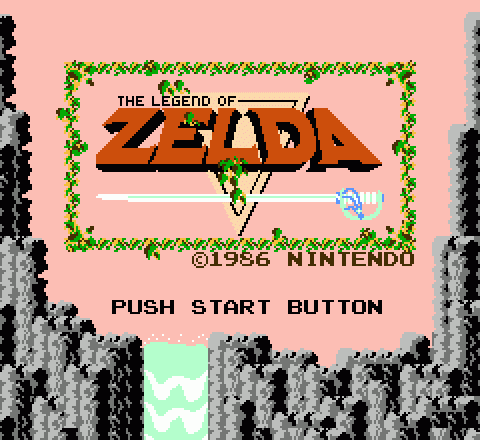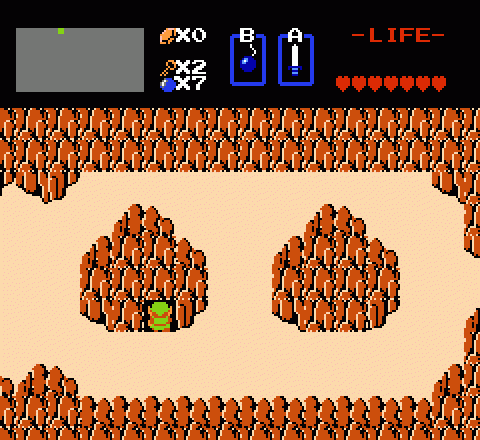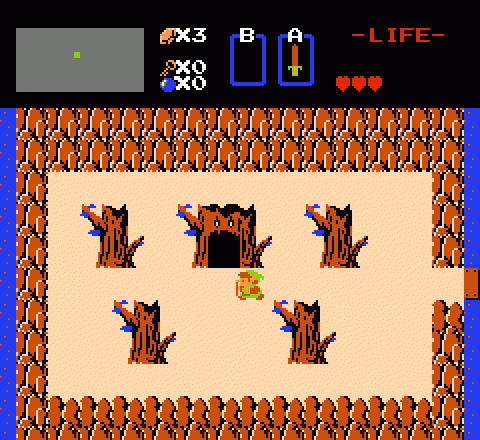I have powerful, lasting memories of The Legend of Zelda. Along with Metroid, Zelda taught me a great deal about the potential of video games and helped cement my tastes in the medium. Exploration, depth, freedom, and just enough challenge to keep things interesting: That’s Zelda. And that’s what I like.
Yet I first played Zelda a quarter-century ago. Games have evolved tremendously in that time. Addictive as I found Zelda in 1987, I think it’s perfectly fair to ask if its design holds up. Sure, I spent countless hours engrossed in Zelda all those years ago, but would the same hold true if I were to discover it for the first time today? Of course, that question is both unfair and impossible to answer; Zelda‘s vintage made it one of the defining works of the medium, and the concepts it put forward eventually became the rules by which video games work. I wouldn’t be able to approach Zelda with the same wide-eyed sense of wonder today, because countless other games have surpassed it by standing on its shoulders.
Still, you can pick apart the game’s workings by objective standards. It may no longer hover at the cutting edge, but does that matter? Good design is good design, regardless of the time and style. And this is the question we’ll be exploring in this Anatomy of a Game series (or die trying).
You know how Zelda begins: Link stands in the middle of a clearing. Paths lead off the screen to the east, north, and west; a cave less than a dozen paces from the starting point also beckons.
Phrased this way, you can see how Zelda derives from the classic text adventures of the ’70s.
You are standing in a clearing, surrounded by high rock walls on all sides. The cliff behind you to the south rises too steeply to be scaled. Winding dirt paths lead through the stone to the west, the north, and the east. Just ahead, the mouth of a deep, dark cave yawns from the rock to the north.
What will you do?
> _
Your opinion of Zelda and the way it handles its quest will likely depend on precisely how much guidance you expect from a video game. Unlike any modern game I can think of save Minecraft, Zelda does nothing to lead you directly. Tips for progress take the form of riddles, some of which don’t necessarily make sense. From the very beginning, you have the freedom to travel any direction (except south) and go anywhere. You’re free to discover, to die, to progress, to fail, to stumble about in confusion. You can complete the dungeons out of order, skip collecting health upgrades, grind for cash: Whatever you like.
Heck, once you have bombs — which here take the form of random enemy drops and merchandise on sale at any number of vendors rather than key acquisitions collected in the course of the main quest — you can go directly to the final dungeon. Fortunately, the later dungeons incorporate safeguards (requirements for entry) to prevent Link from just waltzing in and killing the bad guy right away. But it is entirely possible to beat [edit: Rather, “get all the way to the final boss of”] Zelda without ever acquiring a sword: Collect money from one of the “It’s a secret to everybody” Moblins, buy some bombs, crack open key hidden caves where more money is available on offer, acquire the secondary weapons in the first dungeon, and go about the business of killing everything indirectly.
Zelda doesn’t leave you completely in the dark. Besides the riddles you’ll stumble across, it also exercises some smart, intuitively integrated design choices. Every time you die, you restart at the beginning of the game, so if you don’t think to go into that cave right away and collect the sword within, you’ll be thrust back there soon enough when you wander helplessly into monsters and die a swift death. Zelda‘s start point is set in the bottom-center screen of the overworld map, so it’s easy enough to make your way to where you need to be any time you start the game.
Of course, the crux of Zelda lies in its dungeons: You can explore the world map all you like, but you can’t finish the game until you conquer the dungeons and collect the Triforce shards within. The dungeons become increasingly hard to find as you advance through the game, but the very first stage is located due north of the starting point and one screen to the west across a bridge that provides a curious and unique geographical location. This is the first instance of Zelda capitalizing on the fact that its 3/4-down visual perspective naturally draws players to travel up/north, as it places Link’s back to the player, creating a natural sense of advancement when you move upward. Traveling north creates the same sensation of forward progress that contemporary Zelda games express by setting the camera behind Link’s back.
A player probably won’t find the dungeon immediately, but they’ll stumble across it sooner than later due to its placement on the map and the relationship between Link’s design and its northward orientation. Despite its frequent, maddening opacity, Zelda nudges players in the proper direction from the very beginning. It’s up to you to read the hints and put them into action.
Images in this series courtesy of VG Museum




That text adventure bit blew my mind.
I’ve just been poking through the BS-Zelda “fourth quest”. (Or I was, until it crashed the damn emulator and I lost about an hour.) For all the vexations, it’s amazing how much still holds up.
And, indeed, even how much of the seemingly-arbitrary “bomb every wall, burn every bush” “puzzles” follow rules that you learn and remember. I can tell a rock face that looks like I should try bombing it from one that’s just a rock face with a pretty high degree of certainty, even when the map’s changed around.
Ye find yeself in yon dungeon. Ye see a SCROLL. Behind ye scroll is a FLASK. Obvious exits are NORTH, SOUTH and DENNIS.
Sorry, couldn’t help myself.
(“eventually because” = eventually became”?)
I never consciously thought about how “north” equals “forward” in LoZ . “North” also feels “up”, which makes sense, seeing as the whole northern third of the overworld map is comprised of a rocky shelf overlooking the rest of Hyrule. FUUUU-
In this first entry along, you’ve already given me at least three brand-new perspectives on a game I thought I knew inside and out. This promises to be an exciting and rewarding series. Looking forward to the rest.
I thought you needed the sword to kill Ganon. You can totally get through most of the game and to his room without the sword, but to actually wear him down to use the silver arrow requires the sword…
Not *entirely* possible. You can get to Ganon without a sword, but you can’t hit him with anything but the sword.
Ah, my mistake.
There is a bit of monster gating also found in its early console RPG contemporaries on the overworld, indeed. You’ll encounter easy mooks on the way to the first dungeon, making it the least daunting. On the way to the second, the game begins throwing Moblins at you.
Now doing the latter first isn’t as lethal compared to going off the beaten path in, say, Dragon Quest I (and definitely not Final Fantasy II), there’s still that same invisible guiding hand.
I’ve given thought to writing my own article about 1987, and how it, to me, was right about the time gaming started to rapidly evolve in all sorts of directions.
This remains one of my favorites of the series, just for the sheer amount of freedom it grants the player. Oh, if only they’d make another like this…
The last time they tried to give you a sense of freedom to proceed as you wish, even for just a small, small part of the game, it wound up breaking the blasted thing. =P
Thad: I so, so, so wish they would patch those games up and sell them on WiiWare or the eShop- or both. Or something. Put them all on a disc, maybe with a version of the original game using the same graphics. I don’t care, I just know that I want to play more original-styled Zelda using a boy in a baseball cap or a girl with a red ponytail… or a graphically-enhanced Link.
Choices! I want them!
The Legend of Zelda’s starting area is really brilliant. You’re at the center of the southern side of the world, with three directions you can go and a cave. Putting a cave with your first sword on that first screen is clever as well; most players would likely be curious what’s in the cave right in front of them when they start, and are rewarded for their curiosity.
What’s not as obvious is that all the screens adjacent to the first screen have a secret. The northwest one has a plainly visible shop, with the candle, a key, and a better shield for sale. The north and west screen have bombable walls, with a Rupee-giving Moblin and money-making game old man. And the east and northeast screens have burnable bushes, with an old lady who will eventually sell potions after getting the letter and a more jerkass old man who takes Rupees for door damages.
That starting screen’s also six to seven screens away from both of the game’s fairy fountains.